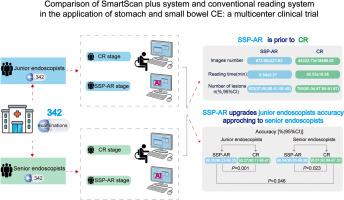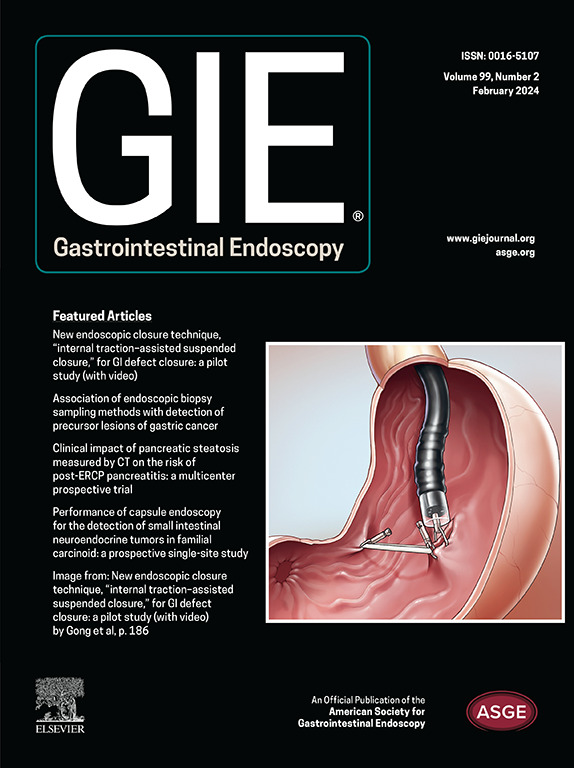用于胃和小肠胶囊内窥镜检查的新型人工智能系统。
IF 6.7
1区 医学
Q1 GASTROENTEROLOGY & HEPATOLOGY
引用次数: 0
摘要
背景与目的:尽管人工智能(AI)在小肠(SB)胶囊内镜(CE)图像读取方面有很多优势,但在胃和小肠CE方面的应用还缺乏相关信息:在这项多中心、回顾性诊断研究中,胃部成像数据被添加到基于深度学习(DL)的智能扫描(SS)中。在识别胃部病变的训练阶段,共使用了 1,069 次磁控胃肠道 (GI) CE 检查(包括 2,672,542 张胃部图像),产生了一种名为 SS Plus 的新人工智能算法。验证阶段包括 342 次全自动磁控 CE(FAMCE)检查。评估了高级和初级内镜医师在 SS Plus 辅助读片(SSP-AR)和传统读片(CR)模式下的表现:结果:SS Plus 可识别 5 种胃部病变和 17 种 SB 病变。SS Plus 将所需的 CE 图像数量减少到 873.90 (1000)(中位数,IQR 814.50-1,000),而 CR 则减少到 44,322.73 (42,393)(中位数,IQR 31,722.75-54,971.25)。此外,使用 SSP-AR 时,内镜医师完成 CE 视频阅读的时间为 9.54 分钟(8.51)(中位数,IQR 6.05-13.13)。在 342 个 CE 视频中,SS Plus 发现了 411 个胃部病变和 422 个 SB 病变,而 CR 发现了 400 个胃部病变和 368 个肠道病变。此外,使用 SSP-AR 后,初级内镜医师的 CE 图像阅读能力显著提高:我们的研究表明,新升级的基于 DL 的算法 SS Plus 可以检测出消化道病变,有助于提高初级内镜医师解读 CE 视频的诊断能力。本文章由计算机程序翻译,如有差异,请以英文原文为准。

A new artificial intelligence system for both stomach and small-bowel capsule endoscopy
Background and Aims
Despite the benefits of artificial intelligence in small-bowel (SB) capsule endoscopy (CE) image reading, information on its application in the stomach and SB CE is lacking.
Methods
In this multicenter, retrospective diagnostic study, gastric imaging data were added to the deep learning–based SmartScan (SS), which has been described previously. A total of 1069 magnetically controlled GI CE examinations (comprising 2,672,542 gastric images) were used in the training phase for recognizing gastric pathologies, producing a new artificial intelligence algorithm named SS Plus. A total of 342 fully automated, magnetically controlled CE examinations were included in the validation phase. The performance of both senior and junior endoscopists with both the SS Plus–assisted reading (SSP-AR) and conventional reading (CR) modes was assessed.
Results
SS Plus was designed to recognize 5 types of gastric lesions and 17 types of SB lesions. SS Plus reduced the number of CE images required for review to 873.90 (median, 1000; interquartile range [IQR], 814.50-1000) versus 44,322.73 (median, 42,393; IQR, 31,722.75-54,971.25) for CR. Furthermore, with SSP-AR, endoscopists took 9.54 minutes (median, 8.51; IQR, 6.05-13.13) to complete the CE video reading. In the 342 CE videos, SS Plus identified 411 gastric and 422 SB lesions, whereas 400 gastric and 368 intestinal lesions were detected with CR. Moreover, junior endoscopists remarkably improved their CE image reading ability with SSP-AR.
Conclusions
Our study shows that the newly upgraded deep learning–based algorithm SS Plus can detect GI lesions and help improve the diagnostic performance of junior endoscopists in interpreting CE videos.
求助全文
通过发布文献求助,成功后即可免费获取论文全文。
去求助
来源期刊

Gastrointestinal endoscopy
医学-胃肠肝病学
CiteScore
10.30
自引率
7.80%
发文量
1441
审稿时长
38 days
期刊介绍:
Gastrointestinal Endoscopy is a journal publishing original, peer-reviewed articles on endoscopic procedures for studying, diagnosing, and treating digestive diseases. It covers outcomes research, prospective studies, and controlled trials of new endoscopic instruments and treatment methods. The online features include full-text articles, video and audio clips, and MEDLINE links. The journal serves as an international forum for the latest developments in the specialty, offering challenging reports from authorities worldwide. It also publishes abstracts of significant articles from other clinical publications, accompanied by expert commentaries.
 求助内容:
求助内容: 应助结果提醒方式:
应助结果提醒方式:


